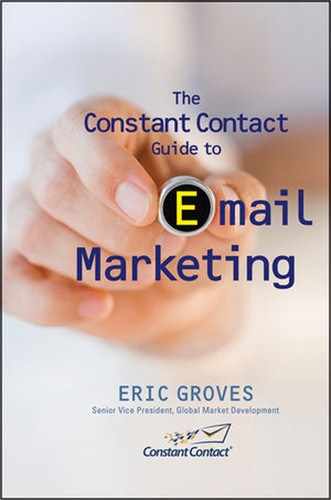Writing Great Email Content
Coming up with email content on an ongoing basis can be challenging, especially when time is a factor. The execution of an excellent email content strategy relies heavily on the effectiveness of the content you write. If you are the person writing for your email campaigns, it would be wise to invest some time into strengthening your skills.
Good copy helps your readers understand what you are offering them and gives them clear ideas on how you want them to respond. The following sections show you Constant Contact’s best copywriting tips and email content sources. Keeping these tips and sources in front of you when you write helps you to create compelling content that engages your readers.
CHOOSE AN AUDIENCE
Before writing your first word of copy, you need to decide who your email is going to be sent to. Picture the people on the list you’re planning to use. Think about what their day is like. Think about what is important to them. What are they passionate about? How old are they? What products or services have they purchased from you in the past and why? The more you know about the audience you are writing for, the more targeted and relevant your content will be.
CHOOSE A CATEGORY
It’s easier to come up with email content when you think of all your sources in categories. It’s also helpful to group the email content you create into categories so you can organize the information into separate emails or separate sections in the same email. That way, you can use different categories of email content to target different interests within your subscriber base. Here are some email content categories you can use to help you in creating, organizing, and targeting content for your emails.
• Share your expertise. You are an expert; at least your customers think of you that way. Share your expertise by writing articles, tips, or by answering customer questions.
• Use facts and testimonials. Facts about your products or your industry, quotes from customers, stories about their experiences, and even advice from your customers can be effective.
• Give guidance and directions. Guiding your customers through steps in a purchase process or giving directions on how to order or how to use your products and services.
• Offer discounts and coupons. Discounts, coupons, contests, and giveaways work for some audiences.
• Exclusivity and VIP status. Special privileges, VIP status, or exclusivity works for others.
• Hold contests and giveaways. You might give a free product or service away to everyone or to one contest winner.
• Acknowledge your audience. A thank-you note or holiday greeting helps to deepen your relationships.
Content categories also vary by industry. Here are some examples of how the aforementioned content categories might be used by different industries.
• Day-Spa: Provide customers with a weekly tip on ways to relieve stress in their lives.
• Financial Consultant: Provide clients with a weekly recap of interesting developments in the financial markets.
• Nonprofit: Provide donors with monthly updates on the impact programs are having in the community.
• Restaurant: Provide customers with fun cooking tips and tricks they can use at home.
• Retail: Provide customers with information on special sales (inventory closeouts or new product arrivals) and featured VIP events.
CHOOSE A VALUE PROPOSITION
A value proposition is a statement that explains why taking a specific action, such as reading your email or making a purchase, is more important than ignoring the proposed action. Answer these questions to determine what your value proposition is:
1. Why should your customers buy your product or service?
2. What’s in it for them?
3. Why is your product or service better than your competition?
CHOOSE A HEADLINE
If you’re going to get your subscribers to read your emails, you need to prompt them to read with a great headline. Your headlines need to grab readers with an obvious “What’s in it for me?” message. Ask yourself: “What if they only read the headline? Will they know enough about me and what I offer?”
EDIT AND CONSOLIDATE
After you write your first round of copy, read it out loud. Also, have someone else read it to see if she immediately understands the message. Once your message is clear, decide whether you can cut out any unnecessary copy. One of the keys to great content is to keep it short. When it comes to content, I like to say “be brief, be bright, be gone.”
As you edit, cut unnecessary words and consolidate ideas. See if you can get your text down to 30 to 50 percent of what you started with. Also, include bullet points and possibly subtitles to make it easy to read. Make your content easy to scan, as most readers scan a page before deciding whether to read all the details.
..................Content has been hidden....................
You can't read the all page of ebook, please click here login for view all page.
